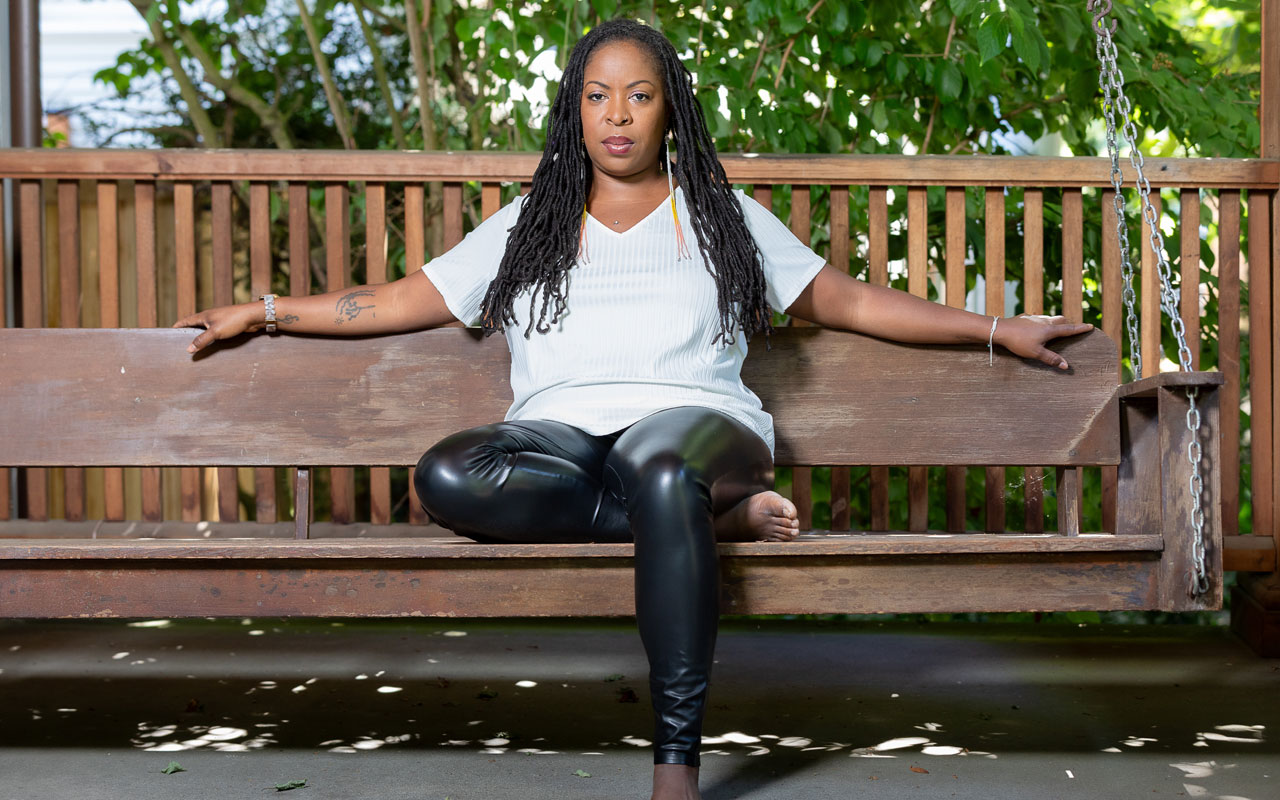
Johnaye Kendrick photo by Daniel Sheehan
“When I’m singing or performing really beautiful, but challenging material [it] becomes a part of me. I see some of the rhythmic or harmonic or melodic ideas creep out of my original work. I don’t realize that it’s happening. But it’s a gift to take that music and let it become a part of me.”
Vocalist and composer Johnaye Kendrick was speaking of her many years working alongside trumpeter and bandleader, Nicholas Payton, but that idea is one that has resonated throughout her storied career. No matter if it’s her own spin on a standard like “The Very Thought of You” or singing one of her original compositions or even doing her work as a sound therapist, the music seems to emanate from somewhere deep within. Her face shifts in reaction to certain lines or words while her arms float and bend along with the melody.
Kendrick’s outward expressions of how sound affects her is not unusual, but it is a key part of the whole experience of watching her perform. And it is key in her ability to be a healing presence to the people in her audience even if she didn’t see herself as such early on. As she recalls, listeners would approach her after gigs to praise her for such. “They’d be like, ‘Oh, I just feel so fed,’” Kendrick says. “I would be like, ‘Okay, thanks, thanks,’ but on the inside it feels like such a selfish thing because I get all this joy out of it.”
Tapping into the healing properties of music and sound waves has led Kendrick into a new career. (In addition to performing and recording, she is a professor of music at Cornish College of the Arts.) From a studio in Tacoma, she offers a variety of sonic treatments from vibrational sound therapy and sound baths as well as work with tuning forks. As restorative as it is for her clients, it is doubly so for Kendrick. She both reaps the benefits of this work by being around these spiritually expanding drones and by letting them feed into her art.
“Every new piece, every new arrangement,” she says, “I’m focused on creating works with healing intent. So, when I get on stage, I set the intention that there is a peace that comes over the audience. That they’re able to feel fed. That there’s a healing that happens, there’s a grounding that happens.”
There will be three opportunities to understand what Kendrick is attempting to do with her music at the 2023 Earshot Jazz Festival where she is being celebrated as this year’s Festival Artist In Residence. On October 7 at Town Hall Forum, she will present Heart Songs, a sneak preview of her forthcoming album, and on October 13 at the Town Hall Great Hall, she will perform with säje, the Grammy-nominated vocal quartet she co-founded with her friends and fellow vocalists Sara Gazarek, Erin Bentlage, and Amanda Taylor.
It’s Kendrick’s performance on November 2 at Raisbeck Auditorium that gets closest to what she hopes to achieve with the music. On that evening, she will debut Grounded, a multi-part suite for jazz ensemble and string quartet where each movement addresses healing with a different chakra. For this performance, Kendrick will be singing and, as she has done regularly at her own gigs, playing the harmonium.
The three sets of music also allows Kendrick to flex her different musical muscles and to truly showcase how far she has come as a jazz artist in a relatively short amount of time. To help create this work, she received support from Chamber Music America and Jack Straw Cultural Center. She admits to being a bit of a late bloomer when it comes to her chosen genre.
She grew up in the Bay Area, studying violin at a performing arts high school and playing with the San Diego Youth Symphony. But around her junior year, she joined her friends in the school’s jazz vocal ensemble and began to fully invest herself in jazz.
“The experience of being on stage and being able to create in the moment that—really spoke to me even while it really frightened me,” Kendrick recalls. “The idea of not needing to do the same thing over and over and having that freedom for self-expression in the moment really spoke to me.”
When she left for college, she gave herself over to jazz entirely, “playing catch up,” as she puts it at Western Michigan University. “I was always wearing headphones,” Kendrick says. “Listening to something, transcribing something. Really working to internalize the language.” She went on to earn a master’s degree in music from Loyola University and an artist diploma from the Herbie Hancock Institute of Jazz.
All of the education and experience Kendrick has accrued in her life has helped not only quell her initial fears about improvising but has also allowed her to embrace those moments onstage when notes get flubbed or, in a rare instance, when a song completely falls apart.
A great example of the latter was a performance she and her quartet undertook recently where the plan was to play a new arrangement of one of Kendrick’s original songs. As she remembers it, she, her bassist, and her drummer went one direction and the pianist went another, landing in a different key from the rest of the band.
“I literally had to stop the song,” Kendrick says. “It was shocking because [the audience] was eating out of the palms of our hands. I was laughing so hard because it was so bad. But it was so beautiful. It is one of my favorite musical moments of my career. It felt like, ‘Yay, I’m so glad that happened.’ It was just so beautifully awful.”